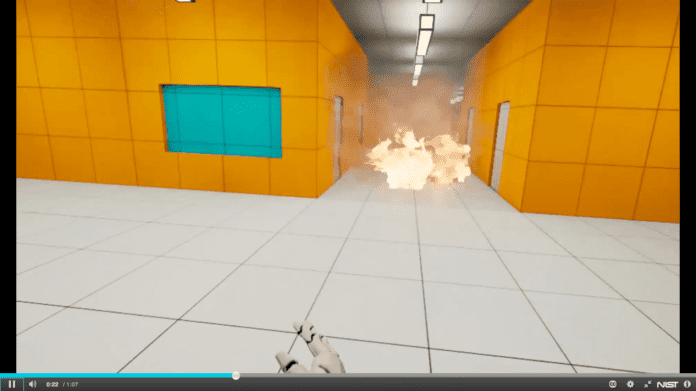In a series of hallways made up of orange, grid-patterned walls and white floors with boxy fluorescent lights on the ceilings, virtual flames crackle and smoke. Suddenly, down another corridor, flames explode out of nowhere. The fire looks and sounds quite real — but everything in the scenario is mere pixels, a virtual reality set-up meant to mimic firefighting in a hotel.
The scenario was created at the National Institute of Standards and Technology, which has developed a test bed for exploring the capabilities of VR to help figure out which user interfaces work best for public safety. The goal of the project is two-fold: to make VR more practical and useful for first responders for learning and practicing their responses in emergencies, and “to spur industry to come up with user interfaces—visual indicators, sounds, voice commands—that are better, cheaper, proven effective and brought to market faster than otherwise would be possible,” said NIST in a blog entry on the work.
In a video showcasing the VR environment, a user stands in a room with a VR headset and hand controllers and must navigate through a maze of hallways, some of which have fires burning or exploding into the frame. The equipment is commercial, but NIST develops the content, tailored to first responders — and has even hired a video game developer, Jack Lewis, who plays the role of the user in the video. Other scenarios including firefighting in a mountain home and an office environment, according to NIST, and users also have a controller that simulates a fire hose. Eventually, NIST said, companies will be able to visit its facilities to “test their experimental interfaces or even replicate the entire test bed.”
“There is currently no method like ours to test and measure user interfaces for first responders,” NIST project leader Scott Ledgerwood said in the blog entry. “We want to enable development, testing and rapid prototyping of these interfaces in a safe, controlled and repeatable environment.” He went on to say that “while there’s been some fantastic advances in training simulation, no one that we know has really looked at it from the testing and development perspective. … We don’t believe anyone else has the focus or capabilities to test user interfaces for first responders.”
This isn’t the first time that video game-like environments have been used for public safety training. Another example is the first-person firefighting video game developed by OhioFirst.net back in 2016 to showcase the potential for firefighters to utilize information sources that could be enabled by a mobile broadband network and applications such as integrated blueprints, real-time mapping and instructions, and thermal imaging to inform their actions.

